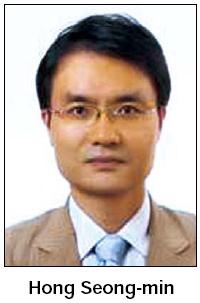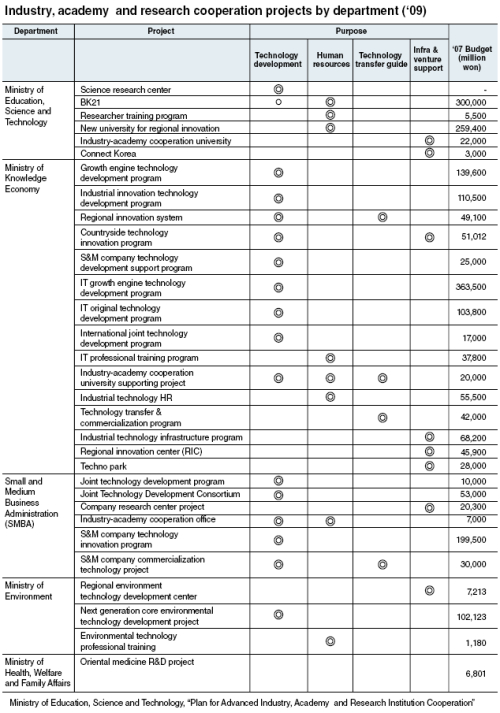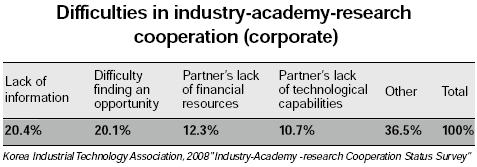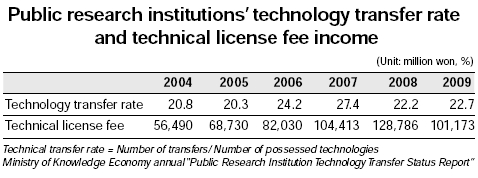[R&D POLICY IN KOREA(41)] Promoting industry and academy cooperation
By 황장진Published : Jan. 13, 2011 - 17:46
Consilience and platforms act as foundation for knowledge connection and integration
This is the 41st in a series of articles introducing the Korean government’s R&D policies. Researchers at the Science & Technology Policy Institute will explain Korea’s R&D initiatives aimed at addressing major socioeconomic problems facing the nation. ― Ed.
As the knowledge-based economy intensifies, knowledge exchange and mutual communication is more significant. New terminology has been created, such as “consilience,” which means the grand unification of knowledge, going beyond the technological convergence.

Here, the term “consilience” refers to the theory of integrated studies connecting natural science and humanities, but it is widely used to link ecology or humanities with technology. The recent development of various social networks has opened up a variety of ways to exchange information and knowledge.
Accordingly, companies are emphasizing open innovation, which is achieving new types of innovation by combining knowledge in R&D and product development. For example, in February 2008, Nokia’s Morph was shown at the San Francisco Exhibition and is a futuristic mobile phone with shape- and color-changing functions that are based on transistor technology that is combined with the basic biology of a chameleon’s color protection and a spider web’s deformability.
Evolution of R&D
In the 21st century, fourth-generation R&D emphasizes R&D and market integration with the aim of creating dominant designs. In order to realize higher value in the market, fourth-generation R&D focuses on relating customer needs and technological innovation capabilities through an interdependent learning process. In another words, this innovative process is a process of platform development.
The process consists of early pilot product development, usability certification and complete pilot product development, acting as the key link in connecting the market to the company’s R&D.
Going one step forward platforms that enable a product’s self-evolution by combining knowledge and ideas are gaining popularity. Generally, a platform with a “standardized hardware and software tool for common and universal use” is flexible in that it can accommodate various applications on a standardized interface, and Apple’s iPhone is a case in point.
The success of iPhone is not necessarily due to the product itself, but rather, it is due to its applications and the “App Store,” where application transactions can take place.
Success factors of consilience
Consilience and platforms act as the foundation for knowledge connection and integration. Success depends on how much the relevant subjects voluntarily participate and come together. Accordingly, recent R&D activities put more emphasis on voluntary industry, academy and research institution cooperation as the key factor in successful R&D results and product development. Advanced nations have already implemented a policy supporting industry, academy and research cooperation and networking as their main R&D policy.

For example, the EU has already established the Innovation Relay Center, which is a technology transfer network, and has announced its plan to expand the network to form the Enterprise Europe Network by integrating with the European Information Center by 2013.
The U.S. has been implementing a policy to promote technology transfer and joint research amongst small businesses, universities and research institutes through the Small Business Technology Transfer Program for a long time.
Japan is continuing its expansion and strengthening of the Technology Licensing Office, which aims to boost universities’ and research institutions’ cooperation with companies.
Incessant political efforts
Since the 1980s, Korea has also pursued policy to promote cooperation among industry, academy and research institutions, such as carrying out projects that support joint R&D. After the new company-oriented policy in 2003, Korea is now pursuing policy to take cooperation a step forward, underscoring the significance of customer needs and participation. The following shows the characteristics of the policy for each era.
First, in the 1980s, most cooperation was carried out through joint research and development between industry and research institutes led by the latter.
Second, in the 1990s, diverse policies to boost industry-academy cooperation were pursued and universities emerged as new participants, shedding light to university-oriented cooperative activities.
Third, after 2002, under the name of “new industry and academy cooperation,” the policy to promote customer-oriented (corporate) cooperation was initiated.
Lastly, the government formed a TF for the “advancement of cooperation among industry, academy and research institutes” and is trying to establish a policy to promote voluntary cooperation that reflects the actual needs of companies. As a result, as of 2009, there are a total of 31 projects that have industry-academy-research cooperation either as its purpose or as its key political means. The Ministry of Knowledge Economy takes the lead with 15 joint R&D projects, followed by the Ministry of Education, Science and Technology and the Small and Medium Business Administration.
Results of cooperation
On that account, the number of joint research projects that have been undertaken by industry, academy and research institutions in association with the government’s R&D projects is on the rise. Among government R&D projects, joint projects accounted for 58.6 percent in 2006 but rose to 74.6 percent in 2009, which means an increase in joint research expenses to about 7,800 billion won.
Furthermore, according to the domestic companies’ R&D cooperation status survey that was conducted by the Korea Institute for Advancement of Technology in 2009, among companies with R&D experience, those that carried out joint projects in the last three years accounted for 53.2 percent, showing an immense leap.
Nevertheless, excluding joint projects that are connected with government R&D projects, there is only a limited level of mutual investment or joint research undertaken voluntarily by industry, academia and research institutes. In particular, only 2 percent of corporate R&D investment is put into universities or research institutions, which is actually a decrease from 1999.
Corporate investments in research institutions rose from 56.97 billion won in 1999 to 114.25 billion won in 2005 but as a share of total investment it almost halved from 0.82 percent to 0.43 percent. Over the same time period, investments in universities increased in absolute terms from 135.83 billion won to 418.93 billion won, but the share of total investment dropped from 1.97 percent to 1.58 percent.

Universities’ and public research institutions’ rates of technology transfer and income earned through technical license fees are increasing. But they have recently stagnated. The technology transfer rate, which refers to the percentage of technology that has been transferred out of its ownership increased from 20.8 percent in 2004 to 27.4 percent in 2007. However, it has been stagnant ever since, recording 22.7 percent in 2009. Technical license fees also increased from 56.49 billion won in 2004 to 128.79 billion won in 2008. It has since decreased to 101.17 billion won in 2009, which is lower than that of 2007.

Obstacles in activating cooperation
Companies pointed out the hardships in finding opportunities for cooperation and insufficient information were the main reasons given for low cooperation. The same result was found in the 2008 Industry-academy-research Cooperation Survey conducted by the Korea Industrial Technology Association, and the 2009 Factors Hindering Industry-academy-research Cooperation Survey that was conducted by the Ministry of Education, Science and Technology. This shows that there is a structural problem that makes cooperation difficult for companies, which account for 75 percent of Korea’s R&D investment.
When exploring and selecting a partner for cooperation, 49.5 percent of conglomerates and 43.2 percent of small and medium-sized companies depend on personal connections. This shows that there is no systematic support for industry-academy-research cooperation.

Networking
One of the major factors that hinder cooperation in Korea is the lack of mutual trust and understanding. The differences in position are clear. Companies think that universities’ technology development capabilities cannot match their demands, while universities think that companies do not participate enough by speaking their own minds or showing interest, and that there is insufficient investment.
The reason for such distrust and lack of mutual understanding is because there are not enough opportunities to cooperate and freely consult each other. As there is no good system that supports activities to find research subjects and exchange opinions for a common goal, the infrastructure for such basic activities to take place is not established.
The current administration’s support system focuses on joint R&D projects that have to make actual progress, which means there is not enough room for industry and research institutions to freely talk with each other during the planning stage, before the actual R&D.
In other words, now is the time to expand the relevant policy to provide more infrastructure for networking activities to take place so that the entities can discuss their common interests such as the planning of research projects. This would be in a form that goes beyond mere friendships, and the discussion itself should be perceived as a purpose.
Common benefit
Another reason why there is insufficient cooperation is because the common benefit that can be obtained through cooperation is small. It is not very attractive for companies that have to make profits and for institutions and universities to actively engage in such cooperation.
Therefore, there are many cases in which the participants are focused on securing research funding instead of research. Their main focus and interest is only to gain government R&D investment. What is making the situation worse is that there are small incentives compared to the efforts that the researchers and university professors put in. For those researchers under the project-based system or professors who are subject to an assessment system, it is more common to put a low value on cooperation, because they may receive a bad evaluation, giving them little incentive to actively cooperate.
In the end, in order to boost cooperation, it is necessary to build a system that will guarantee incentives for cooperation. Not only is it essential for the participants, including companies, research institutions and universities, but also for those people who actually carry out the cooperative activity to be given incentive in order to establish the foundation for voluntary cooperation among industry, academy and research institutions.
By Hong Seong-min
• Hong Seong-min is currently a director of Human Resources Policy esearch Division at the Science and Technology Policy Institute. He received his Ph.D.
in economics at Seoul National University in 2007.
His research career focuses on labor issues such as labor market analysis, human resources development and the cooperation between firms and universities for skilled manpower, especially in the science and technology area.
Since 2009, he has been working on S&T human resource policy at STEPI, after 17 years of research career in related institutes, such as Korea Labor Institutes, Korea Institute for Advancement of Technology etc.
• He can be reached at hsamu@stepi.re.kr
This is the 41st in a series of articles introducing the Korean government’s R&D policies. Researchers at the Science & Technology Policy Institute will explain Korea’s R&D initiatives aimed at addressing major socioeconomic problems facing the nation. ― Ed.
As the knowledge-based economy intensifies, knowledge exchange and mutual communication is more significant. New terminology has been created, such as “consilience,” which means the grand unification of knowledge, going beyond the technological convergence.

Here, the term “consilience” refers to the theory of integrated studies connecting natural science and humanities, but it is widely used to link ecology or humanities with technology. The recent development of various social networks has opened up a variety of ways to exchange information and knowledge.
Accordingly, companies are emphasizing open innovation, which is achieving new types of innovation by combining knowledge in R&D and product development. For example, in February 2008, Nokia’s Morph was shown at the San Francisco Exhibition and is a futuristic mobile phone with shape- and color-changing functions that are based on transistor technology that is combined with the basic biology of a chameleon’s color protection and a spider web’s deformability.
Evolution of R&D
In the 21st century, fourth-generation R&D emphasizes R&D and market integration with the aim of creating dominant designs. In order to realize higher value in the market, fourth-generation R&D focuses on relating customer needs and technological innovation capabilities through an interdependent learning process. In another words, this innovative process is a process of platform development.
The process consists of early pilot product development, usability certification and complete pilot product development, acting as the key link in connecting the market to the company’s R&D.
Going one step forward platforms that enable a product’s self-evolution by combining knowledge and ideas are gaining popularity. Generally, a platform with a “standardized hardware and software tool for common and universal use” is flexible in that it can accommodate various applications on a standardized interface, and Apple’s iPhone is a case in point.
The success of iPhone is not necessarily due to the product itself, but rather, it is due to its applications and the “App Store,” where application transactions can take place.
Success factors of consilience
Consilience and platforms act as the foundation for knowledge connection and integration. Success depends on how much the relevant subjects voluntarily participate and come together. Accordingly, recent R&D activities put more emphasis on voluntary industry, academy and research institution cooperation as the key factor in successful R&D results and product development. Advanced nations have already implemented a policy supporting industry, academy and research cooperation and networking as their main R&D policy.

For example, the EU has already established the Innovation Relay Center, which is a technology transfer network, and has announced its plan to expand the network to form the Enterprise Europe Network by integrating with the European Information Center by 2013.
The U.S. has been implementing a policy to promote technology transfer and joint research amongst small businesses, universities and research institutes through the Small Business Technology Transfer Program for a long time.
Japan is continuing its expansion and strengthening of the Technology Licensing Office, which aims to boost universities’ and research institutions’ cooperation with companies.
Incessant political efforts
Since the 1980s, Korea has also pursued policy to promote cooperation among industry, academy and research institutions, such as carrying out projects that support joint R&D. After the new company-oriented policy in 2003, Korea is now pursuing policy to take cooperation a step forward, underscoring the significance of customer needs and participation. The following shows the characteristics of the policy for each era.
First, in the 1980s, most cooperation was carried out through joint research and development between industry and research institutes led by the latter.
Second, in the 1990s, diverse policies to boost industry-academy cooperation were pursued and universities emerged as new participants, shedding light to university-oriented cooperative activities.
Third, after 2002, under the name of “new industry and academy cooperation,” the policy to promote customer-oriented (corporate) cooperation was initiated.
Lastly, the government formed a TF for the “advancement of cooperation among industry, academy and research institutes” and is trying to establish a policy to promote voluntary cooperation that reflects the actual needs of companies. As a result, as of 2009, there are a total of 31 projects that have industry-academy-research cooperation either as its purpose or as its key political means. The Ministry of Knowledge Economy takes the lead with 15 joint R&D projects, followed by the Ministry of Education, Science and Technology and the Small and Medium Business Administration.
Results of cooperation
On that account, the number of joint research projects that have been undertaken by industry, academy and research institutions in association with the government’s R&D projects is on the rise. Among government R&D projects, joint projects accounted for 58.6 percent in 2006 but rose to 74.6 percent in 2009, which means an increase in joint research expenses to about 7,800 billion won.
Furthermore, according to the domestic companies’ R&D cooperation status survey that was conducted by the Korea Institute for Advancement of Technology in 2009, among companies with R&D experience, those that carried out joint projects in the last three years accounted for 53.2 percent, showing an immense leap.
Nevertheless, excluding joint projects that are connected with government R&D projects, there is only a limited level of mutual investment or joint research undertaken voluntarily by industry, academia and research institutes. In particular, only 2 percent of corporate R&D investment is put into universities or research institutions, which is actually a decrease from 1999.
Corporate investments in research institutions rose from 56.97 billion won in 1999 to 114.25 billion won in 2005 but as a share of total investment it almost halved from 0.82 percent to 0.43 percent. Over the same time period, investments in universities increased in absolute terms from 135.83 billion won to 418.93 billion won, but the share of total investment dropped from 1.97 percent to 1.58 percent.

Universities’ and public research institutions’ rates of technology transfer and income earned through technical license fees are increasing. But they have recently stagnated. The technology transfer rate, which refers to the percentage of technology that has been transferred out of its ownership increased from 20.8 percent in 2004 to 27.4 percent in 2007. However, it has been stagnant ever since, recording 22.7 percent in 2009. Technical license fees also increased from 56.49 billion won in 2004 to 128.79 billion won in 2008. It has since decreased to 101.17 billion won in 2009, which is lower than that of 2007.

Obstacles in activating cooperation
Companies pointed out the hardships in finding opportunities for cooperation and insufficient information were the main reasons given for low cooperation. The same result was found in the 2008 Industry-academy-research Cooperation Survey conducted by the Korea Industrial Technology Association, and the 2009 Factors Hindering Industry-academy-research Cooperation Survey that was conducted by the Ministry of Education, Science and Technology. This shows that there is a structural problem that makes cooperation difficult for companies, which account for 75 percent of Korea’s R&D investment.
When exploring and selecting a partner for cooperation, 49.5 percent of conglomerates and 43.2 percent of small and medium-sized companies depend on personal connections. This shows that there is no systematic support for industry-academy-research cooperation.

Networking
One of the major factors that hinder cooperation in Korea is the lack of mutual trust and understanding. The differences in position are clear. Companies think that universities’ technology development capabilities cannot match their demands, while universities think that companies do not participate enough by speaking their own minds or showing interest, and that there is insufficient investment.
The reason for such distrust and lack of mutual understanding is because there are not enough opportunities to cooperate and freely consult each other. As there is no good system that supports activities to find research subjects and exchange opinions for a common goal, the infrastructure for such basic activities to take place is not established.
The current administration’s support system focuses on joint R&D projects that have to make actual progress, which means there is not enough room for industry and research institutions to freely talk with each other during the planning stage, before the actual R&D.
In other words, now is the time to expand the relevant policy to provide more infrastructure for networking activities to take place so that the entities can discuss their common interests such as the planning of research projects. This would be in a form that goes beyond mere friendships, and the discussion itself should be perceived as a purpose.
Common benefit
Another reason why there is insufficient cooperation is because the common benefit that can be obtained through cooperation is small. It is not very attractive for companies that have to make profits and for institutions and universities to actively engage in such cooperation.
Therefore, there are many cases in which the participants are focused on securing research funding instead of research. Their main focus and interest is only to gain government R&D investment. What is making the situation worse is that there are small incentives compared to the efforts that the researchers and university professors put in. For those researchers under the project-based system or professors who are subject to an assessment system, it is more common to put a low value on cooperation, because they may receive a bad evaluation, giving them little incentive to actively cooperate.
In the end, in order to boost cooperation, it is necessary to build a system that will guarantee incentives for cooperation. Not only is it essential for the participants, including companies, research institutions and universities, but also for those people who actually carry out the cooperative activity to be given incentive in order to establish the foundation for voluntary cooperation among industry, academy and research institutions.
By Hong Seong-min
• Hong Seong-min is currently a director of Human Resources Policy esearch Division at the Science and Technology Policy Institute. He received his Ph.D.
in economics at Seoul National University in 2007.
His research career focuses on labor issues such as labor market analysis, human resources development and the cooperation between firms and universities for skilled manpower, especially in the science and technology area.
Since 2009, he has been working on S&T human resource policy at STEPI, after 17 years of research career in related institutes, such as Korea Labor Institutes, Korea Institute for Advancement of Technology etc.
• He can be reached at hsamu@stepi.re.kr



















![[Today’s K-pop] BTS pop-up event to come to Seoul](http://res.heraldm.com/phpwas/restmb_idxmake.php?idx=642&simg=/content/image/2024/04/17/20240417050734_0.jpg&u=)